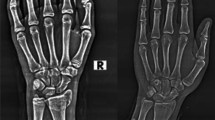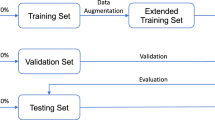Abstract
X-rays are the primary tools in examining the suspected fractures in humans in this era. Manual examination of X rays is a time-consuming process, which requires expert radiologists or trained orthopaedic surgeons. The demanding workloads, unavailability of radiologists in small setups and at primary/community health centres results in the inability to diagnose and delay in the treatment due to unnecessary referrals by the primary care clinicians. Moreover, the shortage of expert radiologists and orthopaedic surgeons in medically under-resourced areas such as rural areas in India have motivated us to develop an automated fracture detection model. We have developed a deep neural network to detect, localize and divide the wrist region into segments to identify fractures around wrist joint in radiographs. The orthopaedic surgeon has manually annotated the fractures by drawing a bounding box and segmented mask. We have utilized two different domains of datasets for the better convergence of the model. There is a similarity in the crack patterns of the surface crack image dataset and the wrist fracture dataset, which consists of 3000 and 315 images. A part of the dataset is made publicly available for research purposes to overcome data collection and labelling barriers for identifying wrist fractures. The crack patterns in the wrist bone samples are learned by effectively transferring the knowledge or weights obtained from surface crack datasets. The proposed architecture utilizes Feature Pyramid Network as the backbone architecture where the last-level max pool layer of the architecture is replaced with the concatenation of AdaptiveConcatPool, AdaptiveAvgPool, AdaptiveMaxPool layers. Additionally, the concept of freezing and unfreezing the network during two phases of transfer learning is utilized for better model convergence. Every radiograph is assigned a ground truth label for evaluating the accuracy of the model. The performance measure for fracture detection and localization is evaluated using the Average precision value using the concept of Intersection over Union. The result of the proposed model is compared against the ground truth label annotated by the radiologists and related studies. The average precision of 92.278 on 50° and 79.003 on a strict scale of 75° was reported for fracture detection. Similarly, the average precision of 77.445 on 50° and 52.156 on a strict scale of 75° was reported for fracture segmentation.












Similar content being viewed by others
References
Lin TY, Dollár P, Girshick R, He K, Hariharan B, Belongie S (2017) Feature pyramid networks for object detection. In Proceedings of the IEEE conference on computer vision and pattern recognition (pp 2117–2125)
He K, Gkioxari G, Dollár P, Girshick R (2017) Mask r-cnn. In Proceedings of the IEEE international conference on computer vision (pp. 2961–2969)
Smith LN (2018) ‘A disciplined approach to neural network hyper-parameters Part 1 – learning rate, batch size, momentum, and weight decay’, pp 464–72, http://arxiv.org/abs/arXiv:1803.09820 [cs, stat]
Berlin L (2001) Defending the “missed” radiographic diagnosis. Am J Roentgenol 176:317–322
Hallas P, Ellingsen T (2006) Errors in fracture diagnoses in the emergency department: characteristics of patients and diurnal variation. BMC Emerg Med 6:4
Guly HR (2001) Diagnostic errors in an accident and emergency department. Emerg Med J 18:263–269
Williams SM, Connelly DJ, Wadsworth S, Wilson DJ (2000) Radiological review of accident and emergency radiographs: a 1-year audit. Clin Radiol 55:861–865
Joshi D, Singh TP (2020) A survey of fracture detection techniques in bone X-ray images. Artif Intell Rev 53(6):4475–4517
Lampert CH, Blaschko MB, Hofmann T (2008) Beyond sliding windows: object localization by efficient subwindow search. In 2008 IEEE conference on computer vision and pattern recognition (pp 1–8). IEEE
Kim DH, MacKinnon T (2018) Artificial intelligence in fracture detection: transfer learning from deep convolutional neural networks. Clin Radiol 73(5):439–445
Chung SW, Han SS, Lee JW et al (2018) Automated detection and classification of the proximal humerus fracture by using deep learning algorithm. Acta Orthop 89(4):468–473
Gale, W., Oakden-Rayner, L., Carneiro, G., Bradley, A.P. and Palmer, L.J., 2017. Detecting hip fractures with radiologist-level performance using deep neural networks. arXiv preprint http://arXiv.org/abs/1711.06504
Lindsey R, Daluiski A, Chopra S, Lachapelle A, Mozer M, Sicular S, Hanel D, Gardner M, Gupta A, Hotchkiss R, Potter H (2018) Deep neural network improves fracture detection by clinicians. Proc Natl Acad Sci 115(45):11591–11596
Yahalomi E, Chernofsky M, Werman M (2019) Detection of distal radius fractures trained by a small set of X-ray images and Faster R-CNN. In Intelligent Computing-Proceedings of the Computing Conference (pp 971–981). Springer, Cham
Thian YL, Li Y, Jagmohan P, Sia D, Chan VEY, Tan RT (2019) Convolutional neural networks for automated fracture detection and localization on wrist radiographs. Radiol Artif Intell 1(1):e180001
Pan SJ, Yang Q (2009) A survey on transfer learning. IEEE Trans Knowl Data Eng 22(10):1345–1359
Johari N, Singh N (2018) Bone fracture detection using edge detection technique. In Soft Computing: Theories and Applications (pp. 11–19). Springer, Singapore
Torralba A, Russell BC, Yuen J (2010) Labelme: online image annotation and applications. Proc IEEE 98(8):1467–1484
Joshi D, Mishra V, Srivastav H et al (2021) Progressive transfer learning approach for identifying the leaf type by optimizing network parameters. Neural Process Lett. https://doi.org/10.1007/s11063-021-10521-x
He K, Zhang X, Ren S, Sun J (2016) Deep residual learning for image recognition. In Proceedings of the IEEE conference on computer vision and pattern recognition (pp 770–778)
Wu Y, Kirillov A, Massa F, Lo W-Y, Girshick R (2019) Detectron2. https://github.com/facebookresearch/detectron2
Lin TY, Maire M, Belongie S, Hays J, Perona P, Ramanan D, Dollár P, Zitnick CL (2014) Microsoft coco: Common objects in context. In European conference on computer vision (pp 740–755). Springer, Cham
Howard J, Ruder S (2018) Universal language model fine-tuning for text classification. arXiv preprint http://arXiv.org/abs/arXiv:1801.06146
Smith LN (2017) ‘Cyclical learning rates for training neural networks’, IEEE Winter Conference on Applications of Computer Vision (WACV), 2017, pp 464–472
Olczak J, Fahlberg N, Maki A, Razavian AS, Jilert A, Stark A, Sköldenberg O, Gordon M (2017) Artificial intelligence for analyzing orthopedic trauma radiographs: deep learning algorithms—Are they on par with humans for diagnosing fractures? Acta Orthop 88(6):581–586
Funding
The authors did not receive support from any organization for the submitted work.
Author information
Authors and Affiliations
Corresponding author
Ethics declarations
Conflict of interest
The authors have no relevant financial or non-financial interests to disclose.
Ethical approval
All procedures performed in studies involving human participants were in accordance with the ethical standards of the institutional. The radiographs are collected from Government Doon Medical Hospital, Dehradun, India, between February 2019 and March 2020. The dataset was acquired without the participant's personal or demographic details under Ethical Conduct in Human Research and Related Activities Regulations.
Additional information
Publisher's Note
Springer Nature remains neutral with regard to jurisdictional claims in published maps and institutional affiliations.
Rights and permissions
About this article
Cite this article
Joshi, D., Singh, T.P. & Joshi, A.K. Deep learning-based localization and segmentation of wrist fractures on X-ray radiographs. Neural Comput & Applic 34, 19061–19077 (2022). https://doi.org/10.1007/s00521-022-07510-z
Received:
Accepted:
Published:
Issue Date:
DOI: https://doi.org/10.1007/s00521-022-07510-z




